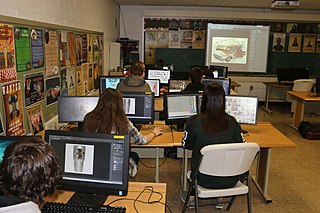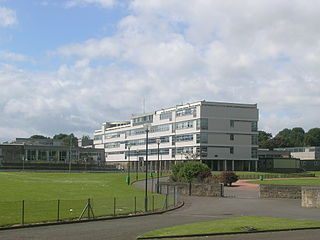Related Research Articles

A student is a person enrolled in a school or other educational institution.
In the education systems of Barbados, England, Jamaica, Northern Ireland, Trinidad and Tobago, Wales, and some other Commonwealth countries, sixth form represents the final two years of secondary education, ages 16 to 18. Pupils typically prepare for A-level or equivalent examinations like the International Baccalaureate or Cambridge Pre-U. In England, Northern Ireland, and Wales, the term Key Stage 5 has the same meaning. It only refers to academic education and not to vocational education.

Education in England is overseen by the Department for Education. Local government authorities are responsible for implementing policy for public education and state-funded schools at a local level. State-funded schools may be selective grammar schools or non-selective comprehensive schools. All state schools are subject to assessment and inspection by the government department Ofsted. England also has private schools and home education; legally, parents may choose to educate their children by any suitable means.
Education in the United Kingdom is a devolved matter, with each of the countries of the United Kingdom having separate systems under separate governments. The UK Government is responsible for England, whilst the Scottish Government, the Welsh Government and the Northern Ireland Executive are responsible for Scotland, Wales and Northern Ireland, respectively.

A state school, public school, or government school is a primary or secondary school that educates all students without charge. They are funded in whole or in part by taxation and operated by the government of the state. State-funded schools are global with each country showcasing distinct structures and curricula. Government-funded education spans from primary to secondary levels, covering ages 4 to 18. Alternatives to this system include homeschooling, private schools, charter schools, and other educational options.

A comprehensive school is a secondary school for pupils aged 11–16 or 11–18, that does not select its intake on the basis of academic achievement or aptitude, in contrast to a selective school system where admission is restricted on the basis of selection criteria, usually academic performance. The term is commonly used in relation to England and Wales, where comprehensive schools were introduced as state schools on an experimental basis in the 1940s and became more widespread from 1965.

A sixth form college is an educational institution, where students aged 16 to 19 study typically for advanced post-school level qualifications such as A Levels, Business and Technology Education Council level 3 (BTEC), and the International Baccalaureate Diploma, or school-level qualifications such as General Certificate of Secondary Education (GCSE) examinations and BTEC level 2 qualifications. In many countries this type of educational institute is known as a junior college. The municipal government of the city of Paris uses the phrase 'sixth form college' as the English name for a lycée.

Twelfth grade is the twelfth and final year of formal or compulsory education. It is typically the final year of secondary school and K–12 in most parts of the world. Students in twelfth grade are usually 17–18 years old. Some countries have a thirteenth grade, while other countries do not have a 12th grade/year at all.
Year 12 is an educational year group in schools in many countries including England, Wales, Northern Ireland, Australia and New Zealand. It is sometimes the twelfth or thirteenth year of compulsory education, or alternatively a year of post-compulsory education. It usually incorporates students aged between 16 and 18, depending on the locality. It is also known as "senior year" in parts of Australia, where it is the final year of compulsory education. Year Twelve in England and Wales, and in New Zealand, is the equivalent of Eleventh grade, junior year, or grade 11 in the US and parts of Canada.
Educational stages are subdivisions of formal learning, typically covering early childhood education, primary education, secondary education and tertiary education. The United Nations Educational, Scientific and Cultural Organization (UNESCO) recognizes nine levels of education in its International Standard Classification of Education (ISCED) system. UNESCO's International Bureau of Education maintains a database of country-specific education systems and their stages. Some countries divide levels of study into grades or forms for school children in the same year.
Year 8 is an educational year group in schools in many countries including England, Wales, Australia and New Zealand. It is the eighth or ninth year of compulsory education. It is known as First Year in Scotland. Children in this year are between 12 and 13. This is generally equivalent to Seventh grade in the United States.
Year 7 is an educational year group in schools in many countries including England, Wales, Australia and New Zealand. It is the seventh full year of compulsory education and is roughly equivalent to grade 6 in the United States and Canada. Children in this year are between 11 and 12.
Year 11 is an educational year group in schools in many countries including England and Wales, Northern Ireland, Australia and New Zealand. It is the eleventh or twelfth year of core education. For some Year 11 students it is their final year studying and may include final exams. In the US and Canada, it is referred to as tenth grade. Students in Year 11 are usually aged 15 to 16.
Year 9 is an educational year group in schools in many countries including England and Wales, Australia and New Zealand. It is the tenth or eleventh year of compulsory education. Children in this year are generally between 13 and 14, with it being mostly equivalent to Eighth grade in the United States.
Year 10 is the tenth year of compulsory education in schools in many countries including England, Australia, India, Northern Ireland, New Zealand and Wales. It is the tenth or eleventh year of compulsory education. It is approximately equivalent to Ninth grade or "freshman year" in the US, and grade nine in Canada. It is the penultimate year of compulsory education. Children in this year are generally 14 or 15 years old.
Year 6 is an educational year group in schools in many countries including the United Kingdom, Australia and New Zealand. It is usually the sixth year of compulsory education and incorporates students aged between ten and eleven. It is generally the same as Fifth grade in the United States, although the birthday cutoff date varies for different countries and schools.
Year 2 is an educational year group in schools in many countries including England, Wales, Australia and New Zealand. It is usually the second year of compulsory education and incorporates students aged between six and eight.
Year 5 is an educational year group in schools in many countries including England, Wales, Australia and New Zealand. It is usually the fifth year of compulsory education and incorporates students aged between nine and eleven.

Secondary education in Scotland can take up to 6 years, covering ages 11 to 18, from S1 to S6. Education is not compulsory after the age of 16, the age of majority in Scots law.
References
- ↑ Guide to Social Security Law, Commonwealth Department of Education, Employment and Workplace Relations, 19 October 1998
- ↑ "School years and levels". Team-up website. Ministry of Education. Archived from the original on 24 March 2009. Retrieved 10 January 2009.
- ↑ "Types of schools". Team-up website. Ministry of Education. Archived from the original on 15 April 2009. Retrieved 10 January 2009.